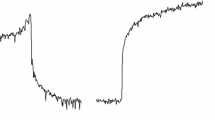Summary
We previously showed that deformation of the cardiac tissue surrounding a dilated coronary artery changes its hydraulic resistance depending on the direction of stretch. Stretch parallel, but not perpendicular, to the vessel axis increased the hydraulic resistance. This asymmetric dependence of resistance on the direction of stretch was found at a low perfusion pressure only, presumably because this was the state in which surrounding fibers were sufficiently stretched to be able to exert their effects. When the vessel is vasoconstricted and its diameter decreases, this might alter the coupling between tissue and vessel. On the other hand, the stiffer vessel wall would be more difficult to deform, making the coupling less evident. The aim of this study was to test the hypothesis that, at this low perfusion pressure, the asymmetric resistance response to strain differs between the vasodilated and vasoconstricted states. We compared how the hydraulic resistance of an in situ segment of a vasodilated and then vasoconstricted epicardial coronary artery was affected by stretching the surrounding tissue by 10% in a direction parallel and then perpendicular to the vessel axis. Vasoconstriction increased the unstretched resistance of the vessel, demonstrating that the vessel diameter was decreased. In both vasomotor states the relative resistance changes to parallel and perpendicular tissue stretches were found to be similar. Thus, the effects of subtle differences in vessel cross-sectional shape underlying the resistance changes to tissue stretch in the vasodilated state — that should have been altered by vasoconstriction — were seemingly counterbalanced by increased vessel wall stiffness that decreased the manifestation of coupling between the vessel and the surrounding tissue.
Similar content being viewed by others
References
Resar J, Livingston JZ, Halperin HR, Sipkema P, Krams R, Yin FCP (1990) Effect of wall strain on coronary hemodynamics in isolated canine interventricular septum. Am J Physiol 259:H1869-H1880
Sipkema P, Yamada H, Yin FCP (1996) Coronary artery resistance changes depend on how surrounding myocardial tissue is strained. Am J Physiol 270:H924-H934
Chew PH, Yin FCP, Zeger SL (1986) Biaxial stress-strain properties of canine pericardium. J Mol Cell Cardiol 18:567–578
Downs J, Halperin HR, Humphrey J, Yin FCP (1990) An improved video-based computer tracking system for soft biomaterials testing. IEEE Trans Biomed Eng 37:903–907
Yin FCP, Tompkins WR, Peterson KL, Intaglietta M (1972) A video dimension analyzer. IEEE Trans Biomed Eng 19:376–381
Halperin HR, Chew PH, Weisfeldt ML, Sagawa K, Humphrey JD, Yin FCP (1987) Transverse stiffness: a method for estimation of myocardial wall stress. Circ Res 61:695–703
McCulloch AD, Smaill BH, Hunter PJ (1989) Regional left ventricular epicardial deformation in the passive dog heart. Circ Res 64:721–733
Waldman LK, Fung YC, Covell JW (1985) Transmural myocardial deformation in the canine left ventricle: normal in vivo three-dimensional finite strains. Circ Res 57:152–163
Demer LL, Yin FCP (1983) Passive biaxial mechanical properties of canine myocardium. J Physiol (Lond) 339:615–630
Lanir Y (1979) A structural theory for the homogeneous biaxial stress-strain relationship in flat collagenous tissues. J Biomech 12:423–436
Viidik A (1978) On the correlation between structure and mechanical function of soft connective tissue. Verh Anat Ges 72:75–89
Abovsky M, Lanir Y, Nevo E (1996) Tethering affects the mechanics of coronary capillaries. J Biomech 29:597–607
May-Newman K, Omens JH, Pavelec RS, McCulloch AD (1994) Three-dimensional transmural mechanical interaction between the coronary vasculature and passive myocardium in the dog. Circ Res 74:1166–1178
Manor D, Williams S, Ator R, Bryant K, Scheel KW (1995) Modulation of coronary flow by left ventricular volume in the presence and absence of vasomotor tone. Am J Physiol 269:H2010-H2016
Sipkema P, Westerhof N, Hoogerwerf N (1997) Rate of myogenic response increases with the constriction level in rabbit femoral arteries. Ann Biomed Eng 25:278–285
Author information
Authors and Affiliations
Additional information
This study was supported by Grant no. HL44399 from the National Institutes of Health.
Rights and permissions
About this article
Cite this article
Yamamoto, S., Sipkema, P. & Yin, F.C.P. Effect of vasoconstriction on coronary artery resistance changes caused by stretching surrounding myocardial tissue. Heart Vessels 14, 9–14 (1999). https://doi.org/10.1007/BF02481738
Received:
Revised:
Accepted:
Issue Date:
DOI: https://doi.org/10.1007/BF02481738




